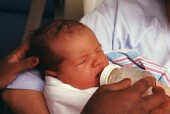
FRIDAY, Jan. 15 (HealthDay News) — The U.S. Food and Drug Administration and other U.S. health agencies are pledging $30 million toward short- and long-term research aimed at clarifying the health effects of the plastics chemical bisphenol A (BPA).
The chemical is ubiquitous in plastic products, including baby bottles and sippy cups, as well as metal linings of some cans, including those containing infant formula. And it has come under close scrutiny in the past year or two with studies linking it to a host of health and developmental problems.
“Recent reports show subtle effects of low doses of BPA in laboratory animals and that has raised concerns so we now are taking a much closer look at BPA,” said Bill Corr, deputy secretary of the U.S. Department of Health and Human Services (HHS), the umbrella organization for the U.S. Food and Drug Administration and other agencies. “We need more research to understand the potential effects on children,” he said.
Corr and other officials spoke at a Friday afternoon news conference.
The FDA stopped short of stating that it was raising its level of concern about the chemical.
“BPA has not been proven to harm either children or adults,” Corr said. “But the data deserves a much closer look because children are being exposed at early states of development.”
“In a word, FDA does support the use of bottles with BPA because the benefit of nutrition outweighs the potential of risk of BPA,” said Dr. Joshua Sharfstein, principal deputy commissioner of the FDA. “If we thought it was unsafe, we would be taking strong regulatory action.”
Sharfstein added that 90 percent of baby bottles manufactured for the U.S. market no longer contain BPA.
In studies released over the past two years, BPA has been linked to heart disease, sexual dysfunction, cancer, diabetes and hyperactivity, as well as aggression in girls. There is also concern that it could have an effect on the developing fetus.
According to FDA Commissioner Dr. Margaret Hamburg, the agency “shared the perspective of the National Toxicology Program of some concern of health effects of BPA.”
The National Toxicology Program’s 2008 report on BPA used more current data and raised more concern than an FDA report on BPA, leading to criticism of the FDA document.
In the NTP report, experts expressed “some concern for effects on the brain, behavior, and prostate gland in fetuses, infants, and children at current human exposures to bisphenol A.”
“What’s happening today is the FDA is saying that our perspective is now in line with [the NTP assessment],” Scharfstein said. “We have some concern in areas they had some concern and are taking action based on that level of concern to understand more about BPA.”
Sharfstein said the agency was also looking also at new regulatory frameworks for BPA, so that officials could act more quickly on the chemical if warranted.
Until the agencies “answer key question and clarify uncertainties about BPA,” the FDA is “taking reasonable steps to reduce human exposure to BPA, supporting industry’s action to remove BPA from baby bottles and cups, facilitating alternatives to BPA for lining of cans, and supporting efforts to remove or minimize BPA in other food can linings,” Hamburg said.
Corr detailed four steps that consumers can take to reduce their BPA exposure:
- As recommended by the American Academy of Pediatrics, babies should be breast-fed for 12 months if possible. The safest and most nutritious alternative is iron-fortified infant formula, even if there are trace amounts of BPA.
- Discard scratched baby bottles and cups as they may harbor germs and may release small amounts of BPA.
- Very hot infant formula should not be put into BPA-containing bottles as BPA could leach from the container to the food.
- Check labels of all bottles and cups to make sure they are microwave and dishwasher safe.
More information
There’s more on BPA research at the U.S. National Institute of Environmental Health Sciences.

